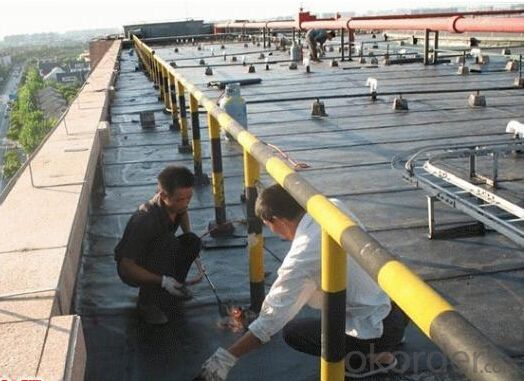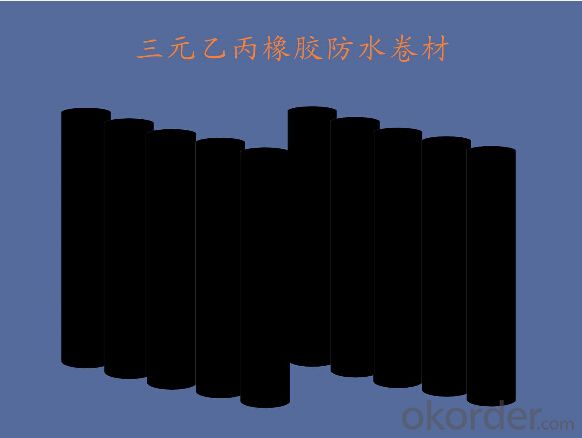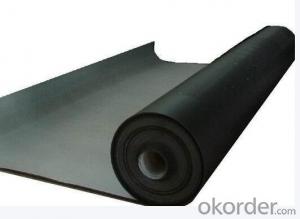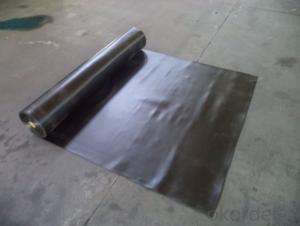EPDM Rubber Waterproofing Roof Membrane Weldable
- Loading Port:
- Qingdao
- Payment Terms:
- TT OR LC
- Min Order Qty:
- 2000 m²
- Supply Capability:
- 100000 m²/month
OKorder Service Pledge
OKorder Financial Service
You Might Also Like
EPDM waterproofing roofing membrane
1. Introduction:
This waterproof coiled material is of high elasticity with best performance among high polymer waterproof coiled material in the world.It is also the most typical one in the world.Waterproof coiled material made of ternary ethylene-propylene rubber is produced the use of the most advanced continuous extrusion and vulcanization technology and related equipments which is specially designed for production of such product.
It is good in compactness,without bubble and performance difference in length and breadth,performances reach or exceed the demands of GB18173.1-2012 standard.
2. Features:
1>Excellent anti-aging performance, service life up to 50 years
2>Working well with in -40°C to 100°C,it can be constructed with a single layer in ambient temperature. 3>Waterproofing on various kinds of underground project,industrial of civil buildings and structures. 4>high extension rate, high tensile strength, small size changes at heat treatment
5>Good plant roots penetrability resistance and can be made waterproofing layer of planting roof
6>Special modified molecular structure ,effectively resolving the current domestic and foreign glue joint problem . 7>Good low temperature flexibility, and good performance of adapting to ambient temperature changes. 8>Convenient application ,solid joint, no environment pollution
9>chemical corrosion Resistance, can be used for special occasions
3. Specification:
Type | EPDM Waterproof Membrane | |||
Material | EPDM Rubber | |||
Thickness | 1.0mm | 1.2mm | 1.5mm | 2.0mm |
Size | 1.2m(width) * 20m(length)/roll | |||
Type | Vulcanized | |||
Pattern | Non-reinforced(homogeneous) | |||
Packing | 24sqm--80sqm/roll, with plastic bag | |||
Color | Black | |||
Application | Roofs, basement, pond, Lake, steel structure roof, swimming pool, underground, tunnel, etc | |||
4. Technical Data:
ITEM | STANDARO REQUEST | |
Tensile strength at breaking,normal temperature,Mpa | ≥7.5 | |
Elongation at breaking, % | ≥450 | |
Tearing strength,KN/m | ≥25 | |
Bending at low temperature | ≤-40°C | |
Water impermeability,0.1Mpa×30min | Impermeability | |
Hot air aging 80°C×168h | Unchanging of tensile strength at breaking,% | ≥80 |
Unchanging of elongation at breaking,% | ≥70 | |
Appearance of 100% elongation | No crack | |
Property of anti alkali 10% Ca(OH)2×168h normal temperature | ≥80 | |
≥80 | ||
5. Some photos:


- Q:Can a waterproofing membrane be used in conjunction with energy-efficient building designs?
- Yes, a waterproofing membrane can be used in conjunction with energy-efficient building designs. In fact, it is often recommended to have a waterproofing membrane as part of energy-efficient building designs, as it helps to protect the building from moisture infiltration and potential damage. By preventing water penetration, the membrane helps maintain the integrity of the building envelope, thus optimizing the energy performance and overall efficiency of the structure.
- Q:Can a waterproofing membrane be used on precast plastic surfaces?
- Yes, a waterproofing membrane can be used on precast plastic surfaces. These membranes are designed to be versatile and can be applied to a variety of materials, including plastic. They provide an effective barrier against water penetration and help protect the underlying surface from moisture damage.
- Q:Can a waterproofing membrane be used for plant rooms?
- Indeed, plant rooms can benefit from the utilization of a waterproofing membrane. These rooms frequently accommodate machinery and equipment that necessitate safeguarding against water and moisture. Employing a waterproofing membrane can effectively avert water-related harm to both the plant room and its enclosed equipment. By establishing a protective barrier, the membrane effectively prohibits the infiltration of water into the walls, floors, and ceilings of the plant room. This becomes particularly crucial in regions prone to water leaks or condensation. Waterproofing membranes are meticulously engineered to endure diverse environmental circumstances, guaranteeing enduring protection for plant rooms.
- Q:Can a waterproofing membrane be used on plywood surfaces?
- Yes, a waterproofing membrane can be used on plywood surfaces. Plywood is a commonly used material for construction, including outdoor projects such as decks and balconies. However, plywood is not naturally waterproof and can be susceptible to moisture damage over time. To protect plywood surfaces from water damage, a waterproofing membrane can be applied. This membrane acts as a barrier, preventing water from seeping into the plywood and causing rot or decay. There are various types of waterproofing membranes available, including liquid-applied membranes, sheet membranes, and peel-and-stick membranes. These membranes are designed to adhere to the surface of the plywood and create a watertight seal. It is important to follow the manufacturer's instructions for proper application and ensure that the plywood surface is clean and dry before applying the membrane. By using a waterproofing membrane, plywood surfaces can be effectively protected from water damage, extending their lifespan and maintaining their structural integrity.
- Q:Are there any specific considerations for installing a waterproofing membrane on concrete surfaces?
- Yes, there are several specific considerations when installing a waterproofing membrane on concrete surfaces. Firstly, it is important to ensure that the concrete surface is clean, dry, and free from any loose particles or contaminants. Proper surface preparation is crucial to allow for proper adhesion of the membrane. Secondly, it is essential to choose a suitable waterproofing membrane that is specifically designed for use on concrete surfaces, as different materials may have different compatibility and performance characteristics. Additionally, the correct application technique and thickness of the membrane should be followed as per the manufacturer's instructions. Finally, it is important to consider factors such as expansion joints, cracks, and structural movement, as these can affect the overall effectiveness and durability of the waterproofing system.
- Q:Can a waterproofing membrane be used in crawlspaces or basements?
- Yes, a waterproofing membrane can be used in crawlspaces or basements. These membranes are specifically designed to prevent water infiltration and are commonly used in these areas to protect against moisture, dampness, and potential water damage. They create a barrier that keeps water out, helping to keep crawlspaces and basements dry and free from water-related issues.
- Q:Can a waterproofing membrane be used on roofs with standing water or ponding?
- No, a waterproofing membrane should not be used on roofs with standing water or ponding. Standing water can put excessive stress on the membrane and compromise its effectiveness, leading to leaks and water damage. It is important to address and correct any ponding issues before applying a waterproofing membrane to ensure its long-term performance.
- Q:Can a waterproofing membrane be used for balconies or terraces?
- Yes, a waterproofing membrane can be used for balconies or terraces. This membrane is specifically designed to prevent water penetration and protect the underlying structure from moisture damage. It creates a barrier that keeps water out, ensuring the longevity and durability of balconies and terraces.
- Q:Are there any specific installation techniques for corners and edges when using a waterproofing membrane?
- Yes, there are specific installation techniques for corners and edges when using a waterproofing membrane. These techniques are important to ensure that the corners and edges are properly sealed and protected from water infiltration. For corners, it is recommended to use corner flashings or preformed corner pieces specifically designed for waterproofing applications. These corner flashings or preformed pieces are typically made of flexible materials such as rubber or PVC and are installed over the membrane to provide a watertight seal. They should be securely fastened to the substrate and overlapped with the membrane to create a continuous barrier against water. When it comes to edges, it is crucial to install edge flashings to prevent water from seeping underneath the membrane. Edge flashings are installed along the perimeter of the waterproofing membrane and are typically made of the same material as the membrane itself. They should be properly sealed and securely fastened to the substrate to ensure a tight and reliable seal. Additionally, it is important to properly overlap the membrane at corners and edges to create a seamless and continuous barrier against water. The manufacturer's instructions should be followed carefully to ensure the correct overlap width and method. Generally, a minimum overlap of at least 2 inches is recommended for corners and edges. Overall, the specific installation techniques for corners and edges when using a waterproofing membrane involve the use of corner and edge flashings, proper sealing and fastening, and correct overlap of the membrane. Following these techniques will help to ensure a reliable and effective waterproofing system.
- Q:Can a waterproofing membrane be used on roofs with skylights?
- Yes, a waterproofing membrane can certainly be used on roofs with skylights. In fact, it is highly recommended to use a waterproofing membrane around skylights to prevent any water infiltration or leakage. Skylights are potential weak points in a roof system, as they create openings that can allow water to seep through if not properly sealed. By applying a waterproofing membrane around the skylights, it helps to create a watertight barrier that protects the roof from any potential leaks. Additionally, a waterproofing membrane can also provide added protection against other elements such as UV rays and temperature fluctuations, prolonging the lifespan of both the skylights and the roof itself.
1. Manufacturer Overview |
|
|---|---|
| Location | |
| Year Established | |
| Annual Output Value | |
| Main Markets | |
| Company Certifications | |
2. Manufacturer Certificates |
|
|---|---|
| a) Certification Name | |
| Range | |
| Reference | |
| Validity Period | |
3. Manufacturer Capability |
|
|---|---|
| a)Trade Capacity | |
| Nearest Port | |
| Export Percentage | |
| No.of Employees in Trade Department | |
| Language Spoken: | |
| b)Factory Information | |
| Factory Size: | |
| No. of Production Lines | |
| Contract Manufacturing | |
| Product Price Range | |
Send your message to us
EPDM Rubber Waterproofing Roof Membrane Weldable
- Loading Port:
- Qingdao
- Payment Terms:
- TT OR LC
- Min Order Qty:
- 2000 m²
- Supply Capability:
- 100000 m²/month
OKorder Service Pledge
OKorder Financial Service
Similar products
New products
Hot products
Hot Searches
Related keywords



























